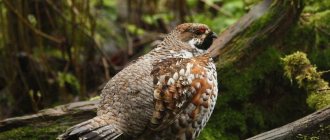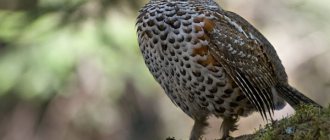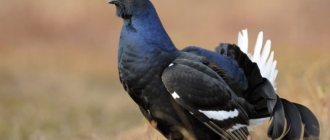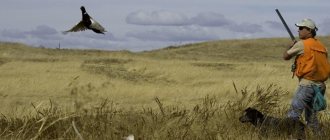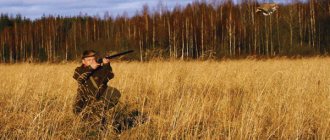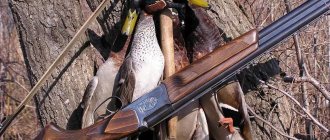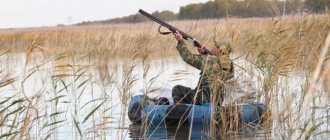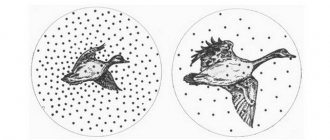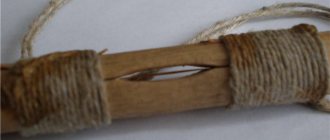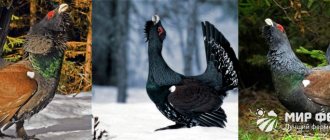Seasonality of hazel grouse hunting
At the end of summer, young hazel grouse become more or less large birds. They stop living with their mother and become independent. Therefore, from this period, shooting at a brood is no longer considered an inhumane activity, and the hazel grouse hunting season . Although the official opening occurs in August, hunters usually go into the forest in September.
At this time, the chance of successful fishing increases significantly, as the hazel grouse begins to display. He strives to find a soul mate and begins to call females invitingly. He flutters between the trees, sings songs, shows off his beautiful body so that the female chooses him to start a family.
The autumn-winter hazel grouse season lasts until the end of spring. In spring, birds begin to breed. They create offspring, care for the brood, teach them to fly and eat. Therefore, hunting hazel grouse in the spring is prohibited. You can only go into the forest with a gun again from the end of summer.
Where to hunt hazel grouse
This species senses weather conditions quite subtly. Any changes in atmospheric pressure also greatly affect the bird. An interesting character trait will be drowsiness and sleepiness, so hunting hazel grouse in the evening will not bring good results. Of course, you can try racing with dogs in the evening, but this is unlikely to be effective. The most productive time for catching game is late in the morning; from 9 a.m. the bird is already actively looking for food. Autumn hunting for hazel grouse with decoy will bring beneficial results if you look for game in windfall forest areas of coniferous forests (Figure 6).
Figure 7. If the basic conditions are met: late morning (after 9 am), autumn, decoy, coniferous forest - you will significantly increase the chances of a successful hunt
Each area has its own specific behavior:
- Hunting for hazel grouse in the Moscow region. In warmer climates it will remain active until November, and for some time in December. The place of your search will be low-growing, dense forests, thickets, and accumulations of dead wood. In this environment, the bird is quite cautious, because it often encounters hunting;
- Hunting hazel grouse in Siberia. At long ranges, the bird behaves according to weather conditions. There is greater interest in uniting in small groups, migrating closer to water bodies and fruiting vegetation. Searches should be focused on areas with the most favorable conditions for game. Thickets of berry bushes near a source of potable water are an excellent option.
Where do hazel grouse live?
The hazel grouse is a sedentary forest bird. She does not like to wander from place to place and likes to feed in her native summer area. These birds feed on berries, flowers, seeds, leaves, herbs, catkins, buds, and young bark of shrubs. In winter, food becomes scarce and therefore the birds leave the main rookery and look for new temporary housing.
The personal territory of a hazel grouse is a section of taiga or mixed forest with a radius of only two hundred meters. This forest dweller loves conifers and deciduous undergrowth. The forest soil must be moist, and springs and forest rivers must flow nearby. If there are a lot of pine trees in the forest and no other trees, then this bird will not like such a forest to live in.
Hazel grouse prefer to live in the forest thicket
Hunting rules
To achieve good success in hunting, you need to follow simple rules. It is necessary to strictly observe the terms of hunting for hazel grouse . Have a hunting license, a weapons permit, a license. While hunting with decoys in early September, a hunter may stumble upon a large brood. In this case, for the sportiness of hunting, it is recommended to shoot at an individual animal scared away by a person, and not shoot a brood.
You should not shoot at the largest bird of the family, because it is a female that can hatch many more young. In spring, the male and female look so alike that hunting is prohibited. Even an experienced hunter in the spring would not be able to distinguish a male from a female, and the bird can turn into a rare forest inhabitant. And in the fall, the female is always larger compared to the rest of the brood.
In winter you can shoot any bird. Hazel grouse are school animals, so if the number of birds of any sex decreases, the population will decrease in any case. When an enemy, including a hunter, approaches, the birds fly up and disperse. Therefore, the hunting tactics are as follows.
You need to notice a specific bird, keep it in your field of vision and shoot only at it. When hunting hazel grouse with a decoy , the bird takes about five seconds to assess the degree of danger. This gives the hunter time to shoot the hazel grouse, which has seen the pursuer and still has not taken off yet.
It is very difficult to distinguish a female hazel grouse from a male, so hunting the bird in the spring is prohibited
They usually go hunting in calm, windless weather without precipitation. On such a day, visibility and audibility in the forest is good. You can see the bird and examine it, and there will be fewer misses when shooting. When searching for hazel grouse in an unfamiliar forest, the hunter usually looks for it in berry areas near a water source. Preference is given to thickets of birch and alder.
The hazel grouse is a slow bird. Therefore, this small bird can be caught without problems, because at the sight of a hunter it runs away or flies no further than fifty meters. She makes her flight low and in a straight line. Having flown several tens of meters, the hazel grouse lands on the lower part of the tree, climbing higher and higher along the trunk. Usually a frightened hazel grouse sits on a Christmas tree.
Autumn hunt
This bird is difficult to confuse with other forest inhabitants. Its colorful plumage gives it away. The average weight of a bird does not exceed 500 grams; with distance, the hazel grouse merges with nature and becomes invisible to the human eye.
Hunting hazel grouse in autumn is especially interesting. It begins in September and continues until late autumn. What's the most effective way to get this little bird's attention? How to hunt hazel grouse with decoy? Professionals are convinced that this option of attracting the attention of birds during the autumn hunt is the most effective. Males fly to the sounds of a decoy or a peep. Guarding their own territory, they react to any sounds made by strangers.
Sometimes a curious female appears behind the male.
The most active hunting for hazel grouse occurs in Indian summer, characterized by warm, quiet weather. On rainy days, birds hide in shelter, so it is quite difficult to detect them.
Since it flies during daylight hours in calm weather, hunting for hazel grouse begins early in the morning. The hunter rushes into the dense coniferous forest where this bird hides its home.
Hunting by season
By the end of August and early September, the young hazel grouse still lives within the family. He gains experience and soon flies away to start an independent life. This is the only time when you can take a hunting dog and go with it on a successful hunt for this upland game. The fishery is carried out in a taiga area with an abundance of wild berries - the favorite food of hazel grouse from July to October.
At the beginning of autumn, hazel grouse mostly do not fly, but walk on the moss. But with the onset of autumn coolness, flights to spruce and other forest trees become a frequent occurrence.
Mating of the birds begins in September. Therefore, success is guaranteed to those hunters who purchased or made their own decoy that attracts hazel grouse. These devices imitate the sounds of birds. The hazel grouse is looking for a mate and hears the sound of a decoy, similar to the singing of a female. He becomes curious and intrigued, flies up to the sound and finds himself in the field of view of the man and the dog.
Winter hunting for hazel grouse begins with the establishment of snow cover. In winter, the forest soil is covered with a thick layer of snow. There are no berries there, so the birds prefer to flutter through the trees, feeding on buds and catkins. To rest at night, the hazel grouse lies down on the lower spruce branch.
In the middle of winter it gets very cold. At this time it is warmer under the snow than in the trees. Therefore, hazel grouse make depressions in the snow, which hunters call holes. Such shelters are warm and are not blown by cold winds. Grouse live in the hole most of the day.
Sometimes they make very large holes and live there, huddled together, so that within a small flock they can warm each other with the warmth of their bodies. Birds briefly emerge from the snow to eat plant food, and again burrow into holes in the snowdrifts. In winter, the hunter goes into the forest on wooden lamps. He shoots the bird from the approach and retrieves it from the holes.
As already mentioned, spring and summer hunting for this upland game is prohibited.
Hunting at different times of the year
in autumn
The most convenient and successful game hunt in the autumn will be hunting hazel grouse with decoy. This is because in the autumn hazel grouse begin to actively create pairs, and therefore, especially the females, are not shy, but open and ready to communicate with a potential male. These decoys can be purchased in specialized stores or made yourself.
There is nothing complicated about making a decoy for hazel grouse. When purchasing a decoy for a male hazel grouse, it is advisable to make sure of the quality and reliability of the squeak extracted; it should be exactly like the voice of a female hazel grouse. And, conversely, to hunt a female, the squeak produced must correspond to the voice of the male.
How to properly attract hazel grouse in the autumn:
- For game hunting, choose a quiet, windless day, preferably without precipitation. If it rains while hunting hazel grouse, you will not be able to lure it with a squeak.
- Hunting for hazel grouse in the fall with decoy should begin in the morning, at 8-9 o’clock until noon. Then there is some lull between the couples. The next bird call should begin no earlier than 14:00 and before sunset.
- Slowly walk around the supposed bird feeding areas. After walking 70-80 meters from the “feeder”, give decoy signals and wait for the sounds of hazel grouse. DO NOT overuse decoy, because representatives of the chicken family are not entirely stupid, and may not fall for the frequent deceptive “screams” of your pika.
- Make a squeak according to the following pattern: 2 hazel grouse voices - 1 decoy squeak, and wait for the next cry of the bird.
- It is preferable to start hunting hazel grouse in the fall by calling a decoy that produces the voice of a female hazel grouse. Because during this period, predominantly male birds respond.
- When the hazel grouse responds to the call of the decoy, stand still, continuing to gradually lure it with the sounds of the decoy. Only after approaching 25-35 steps can you aim at the bird.
- Never shoot a bird at very close range. Point-blank hits will smear your prey across the foliage and grass.
in winter
If you decide to go hunting for hazel grouse with a decoy in winter, then it is better to do this before the end of November, because when the first frosts arrive, the bird will take refuge in the snowdrifts, and a regular decoy will no longer help you. Under the snow “blanket”, hazel grouse arrange shelters for themselves, where even in the coldest winter weather, the temperature in the shelter does not drop below -3-6 degrees Celsius. And in the cold, you will have to hunt game only when it deigns to go out to look for food.
On average, birds emerge from their shelters a couple of times a day, since the birch buds on which they feed are very nutritious.
In winter, there are 3 ways to hunt hazel grouse:
- use special bird traps;
- pull hazel grouse out of holes;
- use a decoy when the bird comes out of hiding.
Bird “bunkers” are quite difficult to detect for a new hunter. They usually nest in them one at a time or in pairs. A distinctive feature of the fact that a hazel grouse is hiding nearby will be tracks in the snow and bird droppings.
Setting traps for hazel grouse is a very difficult and costly procedure. Having set the traps, you will have to constantly go around them, checking for the presence of caught hazel grouse. Therefore, hunting hazel grouse with decoy in winter is no less relevant than in autumn.
Hunting with decoy
The most popular way to catch hazel grouse in the fall is to fish with semolina. The hunter moves through the forest. Usually he does not have his four-legged friend with him - a hunting dog, but he does have a decoy. Experienced hunters make hazel grouse decoys themselves. They imitate the voices of females many times better.
Somewhere in the forest there is a hazel grouse. He is very worried, because at the level of instincts he feels that it is time to start a family. Walking through the autumn forest is very pleasant. There is no longer any summer heat, mosquitoes and midges do not bite. While moving, the hunter constantly makes calling sounds using a decoy. During a stop, he stands quietly and listens.
Only an experienced hunter can see the movements of a hazel grouse and hear its voice. Therefore, young people try to ask to hunt with an experienced hunter in order to learn in practice the intricacies of catching upland game. And somewhere there is a response.
This is the voice of a hazel grouse who heard the sound of a decoy. He flew very close and exposed himself to the shot. Even if he managed to escape, he would still be found somewhere nearby, sitting on a spruce branch. Some hunters take a decoy with them even when hunting from the approach.
Grouse are very responsive to decoys, so hunters often use this method
Hunting from the approach
This hunting option does not involve organizing a preliminary ambush or luring game by simulating a cry. A hunter, wandering through places where birds live, tries to scare away the game from the territory. When birds take off from their homes, it is important for the hunter to monitor the place where they land. Having silently approached the new location of the hazel grouse, the hunter needs to fire a shot at the game. You should know that the hazel grouse does not allow hunters to come closer than fifteen steps. Considering that these birds are capable of flying only short distances, hunters do not have much difficulty in tracking their movements.
Catching hazel grouse from the approach
The hazel grouse is a secretive bird, but does not have intelligence. Therefore, the hunter manages to get as close as possible to upland game without the help of a dog and a decoy. After the bird detects an enemy, the bird noisily but slowly flies away very close. The flight goes in a straight line and ends with the bird landing on a spruce branch.
During the pause between the bird detecting danger and its takeoff, a gun shot is fired. A person has three to five seconds to do this. If he is late or misses, he will have to look for unshot game. The flight is always in a straight line, so the hazel grouse usually always becomes the victim.
The loser falls to the ground and all that remains is to pick him up. During the flight of many birds at the same time, attention is focused on a specific individual. The hunter's movement should be as silent as possible. Then the bird calms down and allows itself to be brought as close as possible. With the onset of winter cold, hazel grouse are caught from the approach in the bushes of young aspen, where the birds are busy eating buds and tips of branches.
Surge hunting
Hunters also catch hazel grouse by driving. To do this, a large number of fishermen are divided into two groups. The first group turns into beaters, the second into shooters. Elk and roe deer are caught this way, but hazel grouse can also become a victim of a hunting team. In the forest, people line up. The first line of hunters are the beaters, who make noise and move towards the shooters. Alarmed hazel grouse move away from the beaters towards the shooters, who are lined up in one line and behave quietly.
The birds sense the approach of the beaters, become excited and run away to the branches of the fir trees, in the direction opposite to the beaters. The birds are getting closer and closer to the shooters, who can only accurately shoot at the hazel grouse perched on the trees. On such a hunt, extreme caution should be taken so as not to shoot in the direction of people.
They always shoot up into the trees, where the feathered inhabitants of the forest, excited by the noise of the chase, try to hide. You can go hunting with a drive not in a large group, but together. They go towards a forest river or taiga stream. There is a lot of moisture there and hazel grouse really like such areas of forest. The tactics of such a hunt are as follows.
The first man sits in ambush. The second one goes off on a side route for a kilometer. He drives the hazel grouse towards his friend sitting in ambush. Along the way, he can shoot the discovered hazel grouse. After the hazel grouse were frightened and ran towards the ambush, a second front opens there. As a result, the two manage to catch more than a dozen birds.
The method of hunting with a surge is used only by experienced hunters
Hunting with a dog
Hunting hazel grouse with a dog is quite difficult. The husky and the pointer use barking and make stances, but the birds manage to hide. Therefore, this tactic is used only at the beginning of the autumn season. Then you can catch the young ones. These fools do not yet know how to beware of the stance. They go hunting with a dog at dawn. The location of the birds is determined by the dog's stance.
Young hazel grouse are not afraid of the dog and therefore, following the tips of the four-legged assistant, it is possible to find the hazel grouse on a nearby Christmas tree. They always shoot at a bird starting to take off. For this method of hunting, you should take experienced and well-trained hunting dogs. If the husky does not have experience hunting hazel grouse, then the birds can easily escape.
The dog should not bark loudly, he should make several sound signals and be able to indicate the location of the bird with his eyes. The smartest and most capable huskies know how to remain silent and follow the birds sitting in the tree with their gaze. In this case, the hunter can catch a lot of hazel grouse. He will definitely thank his four-legged assistant, will be proud of his abilities and will always take him hunting upland game.
By mid-autumn the hazel grouse are growing. Teenage birds become more cautious and therefore immediately fly away at the sight of a dog. Therefore, since October they no longer take dogs into the forest.
Types of hunting
We have looked at the timing of hunting for hazel grouse, now we will dwell in more detail on its types. On the territory of our country, hazel grouse is hunted in all regions. The exception is Kamchatka. This bird prefers to live in dry, dense forests, as well as in ravines overgrown with small bushes. The hazel grouse clings to the branch and hides behind the branches, so it is quite difficult for the hunter to see it at a great distance. The bird is distinguished by its mobility, so at the slightest danger, hazel grouse take off. They typically gather in pairs in the autumn.
The essence of hunting with a decoy is to lure the bird with a sound similar to the whistle of a female or male. The hazel grouse flies up to the signal, as the bird has exceptional hearing. The hunter needs to set up an ambush near the habitat of the hazel grouse from early morning. To attract the bird, the hunter periodically emits a whistle. It is important to understand: the sounds made by a male and a female are significantly different.
Professionals use such knowledge to attract hazel grouse from opposite individuals, basing their decoy hunt on this in the autumn.
Using a shot load, the hunter must make an accurate and lightning-fast shot at a hazel grouse that has “pecked” at the decoy.
Hole hunting
Autumn hazel grouse can be found by droppings, voice, and food remains. But in winter the snow falls deeply, and it becomes more difficult to find the hazel grouse. The winter habits of this bird are as follows. She hides in snow holes most of the day and occasionally flies out to feed. Hunting for hazel grouse in winter is even more exciting than in autumn. They don’t take a dog or a decoy, but it’s so interesting to wander through the frosty winter taiga.
The snow crunches pleasantly underfoot, and traces of many forest inhabitants are visible. But the ski hunter is only interested in the hazel grouse hidden in the snowdrifts. The hunter walks slowly to the edge of the forest and waits for the birds to fly out.
Winter hazel grouse lives in a hole in pairs, less often in a small flock. If the hazel grouse saw a person approaching and managed to take off, then you should shoot in flight or take a closer look at which branch the bird sat on.
Some forest birds, including the hazel grouse, like to hide under the snow
Hunter's equipment
The standard set of equipment for hunting hazel grouse includes:
- light gun or pneumatic;
- bandoleer with a lid to protect cartridges from getting wet;
- comfortable waterproof clothing in soft colors;
- rubber boots;
- Panama hat or cap with mesh to protect against flying insects;
- a small supply of food and drink;
- hunting knife;
- binoculars and compass;
- set of decoys.
You should not take too many things, since when hunting hazel grouse you have to move around quite a lot. When spending the night in the forest, you need to take with you a duffel bag with a set of spare linen, also put matches, socks, a flashlight, a mug, a bowler hat, a hatchet and a light tent.
Hunting hazel grouse in the North
Northern hunting has some features compared to the fishing activities of residents of the central regions of our huge country. Here the leaves turn yellow earlier, and snow falls already in October. By November, permanent snow cover is already established. The northern hunter determines the presence of a bird in the forest by the noisy fluttering characteristic of hazel grouse.
They leave droppings on fireplaces and bathing suits in the taiga. Hazel grouse are often hunted here using a homemade decoy-picker. Arkhangelsk and Komi hunters prefer to hunt hazel grouse from late summer to mid-autumn. After leaf fall, the decoy no longer works on birds that have managed to split into pairs.
With the onset of golden autumn, a variety of colors appears in the forests. Here it is customary not only to bring home prey in the form of upland game, but also to collect gifts of the forest in a backpack: milk milk, milk mushrooms, chanterelles, lingonberries, blueberries, cranberries. It is joyful for a northern hunter to walk through his native forest. These regions of the country are sparsely populated, so there are still a lot of animals and birds here.
Hazel grouse easily respond to the sound of a decoy squeak. These motley birds sit on a branch, can even see the hunter, and are not distinguished by their timid disposition compared to their more southern relatives. They stretch their necks, raise their beautiful crest and look out for the female making the call signs. The hunter does not hesitate to shoot so that the bird does not come to its senses.
The skills and methods of hunting hazel grouse are passed on by northern peoples from generation to generation.
The sound of the northern decoy is so reminiscent of the voices of hazel grouse that the bird is not afraid and remains to wait for its soul mate. But such hunting skills are honed over years. The old hunter always passes on the secret of his skill to his son. Many northern people have been good hunters for several generations. They do not buy metal and plastic store-bought decoys, but make them from an old cartridge case, hare or goose bone. These devices have excellent tonality and sound very authentic.
In addition to hunting with a homemade decoy, northerners also successfully hunt from the approach. They look for hazel grouse in lingonberries, because lingonberries are the main food for northern hazel grouse. When birds see a person, they fly away to a maximum of 150 meters and begin hiding again. In the northern forests, mainly spruce and pine trees grow. There the bird manages to camouflage itself perfectly among the pine needles and spruce branches. Therefore, the hunter must have good eyesight in order to spot hidden upland game in the crown of a tree.
